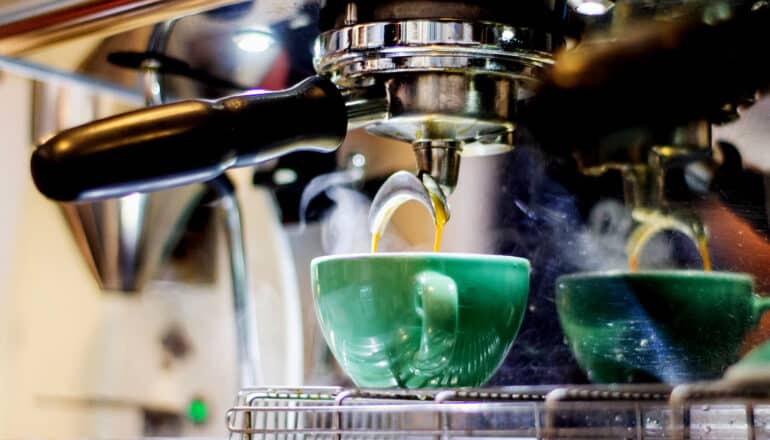
Adding a squirt of water to coffee beans before grinding reduces static electric charge on the coffee grounds, new research shows.
That reduces microscopic clumping of the grounds during brewing, ensuring that water moves through the packed grounds more evenly and thoroughly.
“For brew methods like espresso, having consistent flow is a good thing,” says University of Oregon chemist and study coauthor Christopher Hendon, AKA “Dr. Coffee.” It cuts down on cup-to-cup variability and allows baristas to use slightly less coffee, because less gets left behind.
For a coffee shop that’s slinging espresso shots left and right, reducing a little waste with each cup could make a big difference in their bottom line over the course of a year. Reducing static has potential to affect everyone from home brewers to industrial scale coffee producers.
And from an academic perspective, “We didn’t know how much charge accumulated on coffee, and that it depended on water content,” Hendon says. “That’s powerful, because it means you could turn charging on and off.”
Hendon and his colleagues report their findings in the journal Matter.
The project fittingly arose over a cup of coffee. Hendon’s coffee lab hosts regular coffee hours for the campus community; volcanologists Josef Dufek and Josh Méndez Harper are frequent attendees. Gathered at the coffee bar in a science building atrium, the pair saw similarities between Hendon’s lab’s subject of choice—coffee—and the plumes of volcanic ash, magma, and water that they usually study.
“Coffee provides a nice platform to explore particle-scale physics that occur in volcanic plumes but are obviously very difficult to study directly in nature,” says Méndez Harper, a former project engineer in Dufek’s lab who is now at Portland State University. Both involve materials in different states of matter interacting with each other. But coffee is a lot less dangerous than broiling hot ash and gas, and it’s much easier to study in a controlled way.
In a 2020 paper, Hendon’s team found that especially at fine grind levels, coffee forms microscopic clumps. While invisible to the naked eye, those clumps decrease the extraction yield of the coffee. That is, the water doesn’t touch every coffee ground evenly, resulting in wasted material and cup-to-cup variability.
Here, Hendon’s lab set out to understand why those clumps form and how to eliminate them. He suspected that static electricity might be a culprit.
Some baristas already add a squirt of water before grinding to cut static, an approach known in the industry as the Ross droplet technique. But nobody had specifically measured the charge on coffee or explored how it might vary with different types of coffee, Hendon says.
By collaborating with Dufek and Méndez Harper, Hendon’s team repurposed a tool that has been used to measure electric charges on wildfire and volcanic ash.
This time, they ground coffee above the instrument, a small metal vessel about the size of an espresso cup called a Faraday cup and collected coffee particles falling into it. Because particles are charged, they produce measurable currents when they enter the cup. The larger the charge on the particles, the larger the current.
Aided by a team of undergraduate and graduate student researchers, they tested many different coffee varieties, roasting levels, and grind sizes to understand how different variables affected the charge.
The internal moisture of the beans made a particularly big difference. Clumping was more of an issue in dark roast coffees, Hendon notes. Dark roast coffees tend to have less moisture because they’re usually roasted longer. Also, dark roasts tended to have a negative charge, whereas lighter roasts—which have more residual moisture—acquired a positive charge.
And adding a splash of water pre-grind removed the static charge and reduced the clumping effects, the researchers found. And it got them 10% more yield from the coffee. For baristas, this could be a valuable strategy to waste less coffee: fewer grounds get stuck behind in the grinder, and the water moves through the packed grounds more evenly.
“Some baristas may have already anecdotally arrived at our conclusions; it’s validating some industry know-how,” Hendon says. “We are advocating for yet another step in producing excellent quality coffee, but it turns out you can’t cut corners if you want to achieve excellence.”
The static comes from the cracking and rubbing of the coffee beans against the burrs of the grinder, Hendon believes. But since it’s influenced by the internal moisture content of the beans, it’s something roasters could potentially control for by adjusting the roasting temperature and time.
Meanwhile, Dufek, and Méndez Harper see takeaways for their research on volcanoes. How particles break, or fragment, is one of the leading controls on eruption behavior; grinding roasted coffee is a way to explore the physics of fracture.
Like coffee, volcanic ash particles can be highly charged. That charging can lead to dazzling volcanic lightning storms, but it can also influence how long volcanic ash stays in the air and how far it travels after an eruption.
And as in coffee, water also plays a salient role in volcanic eruptions.
“Explosive volcanoes have a lot of water vapor that helps drive and shape the eruptions,” Dufek says.
“Ultimately, this project really shows the value of community efforts,” he adds. “A coffee hour where people gather provides time and space to think about what’s convergent with research.”
The research had funding in part from the Department of Energy, the National Science Foundation, and NASA.
Source: University of Oregon
The post Volcanology has a trick for making better espresso appeared first on Futurity.
from Futurity https://ift.tt/z80L5fb
No comments:
Post a Comment